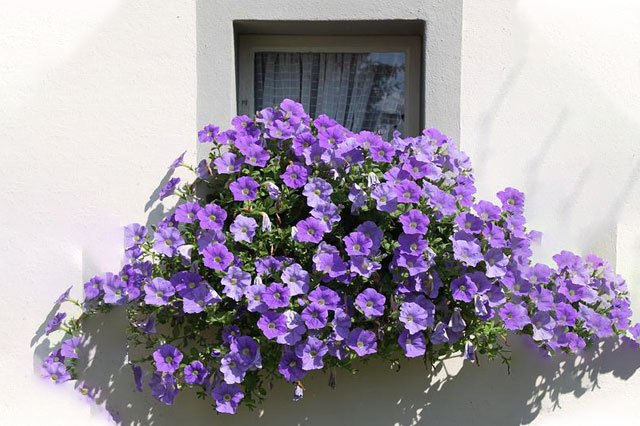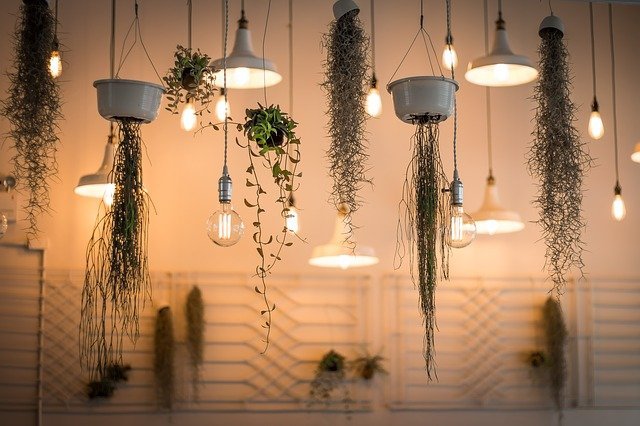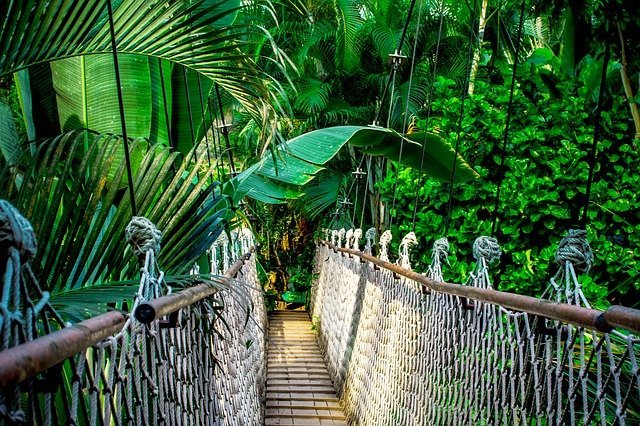Emergent plants grow near the water, river edges, streams and on low flood plains. it mostly grows in a shallow water because these plants have deep and thick roots. Emergent plants stand on top of the water surface to get direct sunlight and Carbon Dioxide. These plants provide a habitat for birds, insects and for underwater creatures.
If you have emergent plants in your aquarium, your fishes in aquarium will love to have them as some fishes like to eat these plants. It also stops the growth of algae and helps to improve water quality as they absorb nutrients from the atmosphere.
Emergent plants enhance the beauty of your aquarium as it provides a natural atmosphere for fishes. All the fishes use it as a nest.
Below are Top 5 emergent plants for your aquarium that will thrive both up and below the surface of water.
1. Water Primrose
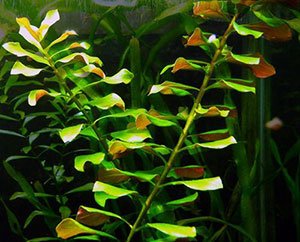
The tropical North and Central American plant is a colorful plant which is one of the most popular Emergent aquarium plant.
This plant can grow both up and below the surface of water because this is an amphibious plant.
The color of this plant changes according to the atmosphere in which they grow and gives you a refreshing vibe.
To propagate this plant, you should collect the seeds of this plant carefully or you can do cuttings.
Water primrose plants need proper care as it requires proper light conditions, fertilizers and trace elements.
Physical characters and parameters
Leaves:
- 6-inch long oval or sword shape covered with soft hairs
Flowers:
- 4 to 5 petals of yellow color flower blossoms in every season except in winters.
Stem:
- it is covered with long soft hairs and have lots of combine branches stick together.
Water condition:
- The temperature of water should be between 72-82 F and the PH of water should be 6.5-7.5.
Cost:
- Around 2$
2. Shade Mudflower
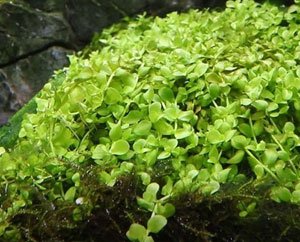
Shade Mudflower emergent plant known as “pearl grass” found in northern Argentina. This emergent plant can grow rapidly to cover the floor of your emergent plants aquarium.
The color of this plant is bright green like a cricket court grass. This plant is emergent in summer season but in winters, it starts to submersed.
Shade Mudflower needs less care with proper light condition and CO2 injection for its proper growth.
To propagate this plant, cut new growth along with roots and store it in a plastic bag. After some days, pour it into the ground level of your emergent plant aquarium.
This plants are used as food by fish and other species.
Physical characters and parameters
Leaves:
- Leaves of this plant are small and round in shape with max size of 2-inchs.
Flowers:
- Small white color flowers with green from the center.
Stem:
- The stem of this plant is light green and bushy.
Water condition:
- The PH of water should be between 6 to 7.5.
Cost:
- Around 8$
3. Java moss
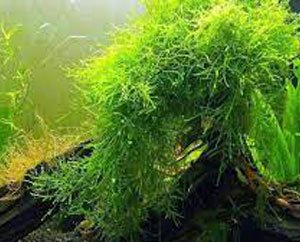
Java moss is one of the most famous emergent aquarium plant which is found in southern Asia. This plant has no roots and have tiny green stems.
Java moss emergent plant can anchor itself on any type of surface with its thin green stems. This emergent plant can keep your tank clean and attractive.
The main problem with java moss is growth of algae. It is not easy to control algae if it spreads in your tank. Try to avoid too much light in the tank because it gives birth to algae.
Physical characters and parameters
Leaves:
- Leaves of this plant are tiny green.
Flower:
- This plant has no flower.
Stem:
- This emergent plan has no roots.
Water condition:
- The temperature of water should be between 59 to 85 F and PH level should be 5 to 8.
Cost:
- Around 8$
4. Giant Hygro
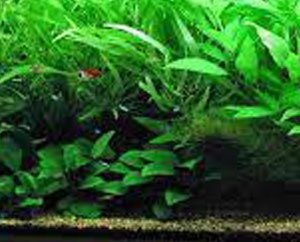
Giant hygro is another popular emergent aquarium plant that can grow very fast. It is a beautiful emergent plant that produces a beautiful velvet color flower with lots of green bushes.
If you want to grow this emergent plant, then it needs a proper fertilizer which is rich with trace elements. The background of aquarium will look beautiful and attractive if you have Giant Hygro emergent plant on the back of your aquarium.
Physical characters and parameters
Leaves:
- Leaves of this plant 20-inchs long.
Flower:
- This plant has a velvet color flower with green leaves.
Stem:
- 24-inches long green stem.
Water condition:
- The temperature should be 72 to 84 F and the PH of water should be 6 to 7.5.
Cost:
- Around 5$
5. Dwarf Hair Glass

Dwarf hair glass is another type of emergent plant which is one of the most popular emergent aquarium plant. This plant is a fresh water plant that can grow both in and out of the water.
Dwarf hair grass is a fast growing plant that is used to cover the floor of the aquarium tanks. It has numerous benefits as it can remove pollutant, control nitrate level and provide shelter to the fishes.
This plant is also a source of food for fishes and provide habitat for different sea creatures. If you have dwarf hair grass in the bottom of the tank of your aquarium, it looks like a small portion of the bottom of the sea.
Physical characters and parameters
Leaves:
- Leaves of this plant are 6-inch long and have a bright green color.
Flower:
- This emergent plan has no flower.
Stem:
- The stems of this plant are bright green in color.
Water condition:
- The temperature of the water should be between 80 to 85 F and the PH of water should be 6.5 to 7.5.
Cost:
- Around 5$
Propagation and care of Emergent plants

As we know that you cannot grow emergent plant with in a minutes. It needs proper propagation and care of emergent plants.
For better growth of emergent plants in your tank or aquarium, you should have a suitable soil, controlled level of CO2 and some other trace elements.
To maintain and propagate emergent plants, you should follow this guidance.
Soil
Soil is the base of having a healthy and successful planted aquarium. If your soil is not good, you will struggle to get a healthy and attractive planted aquarium.
Some of emergent plants can grow on any type of surface but some emergent plants need proper soil to grow. You should check proper requirements before placing any plant in your aquarium or tank.
Placing your emergent plant is the next step after the selection of the soil. Place it in a right place in your aquarium because some plants grow large and will be notable.
Light
Some plants need proper light for growth and to give vibrant color. It is important to know what type of plant you are growing in your tank because some plants need less light while others need more light for healthy growth.
Don’t use direct sunlight for your tank because it can kill both plants and fishes. If you are using direct sunlight, please make sure you tank is cover up with shelter.
Nutrients
Carbon dioxide and Nitrates are very important for healthy and successful growth.
For CO2, you can use a diffuser in which you can inject CO2 and for Nitrates, put Potassium Nitrate regularly in your tank.
Excess of everything is bad so don’t use too much CO2 and Nitrates because it is not healthy for fish.
Water conditions are not much important because most of the emergent plants are hardy and will go fine under any water condition.
Weather condition
We all know the general knowledge that emergent aquarium plants need light, stable CO2, and some nutrients for their healthy growth but we didn’t discuss about the effect of temperature on emergent plants.
Most of the emergent plants comes from a tropical area in which these plants preferred warm weather conditions. The ideal temperature for your aquarium is 78F. Most of emergent aquatic plants do well under this temperature of water. Under this temperature, these plants grow faster and propagate at steady rate.
Temperature play an important role in the growth of aquarium plants because metabolism of plants is effected by temperature. If the temperature is more than usual, it increases the metabolism rate which speeds up the growth of plants. If the temperature gets too hot, then the plants will do poor growth and may even die.
Temperature also effects the presence of the aquatic plants. Some aquatic plants like to grow in warm water but some are not. Some species of aquatic plants will grow more compact under hot weather condition.
Some species of emergent aquatic plants like cool temperature to grow and spread different and beautiful colors in aquarium. In cooler water, these plants have much more steady metabolism which decreases the intake of CO2 and nutrients.
Temperature has a major effect on the growth of emergent aquatic plants but we often overlook this perimeter.
Conclusions
You should be humble while growing emergent plants because these plants need proper time and care to grow. Fertilizers can be used but don’t over use any fertilizer because it can cause some serious effects on fishes and other creatures. Make sure you clean the tank or aquarium regularly because if you don’t do that, then the birth of algae will take place in your tank and it becomes very difficult for you to get rid of algae.


